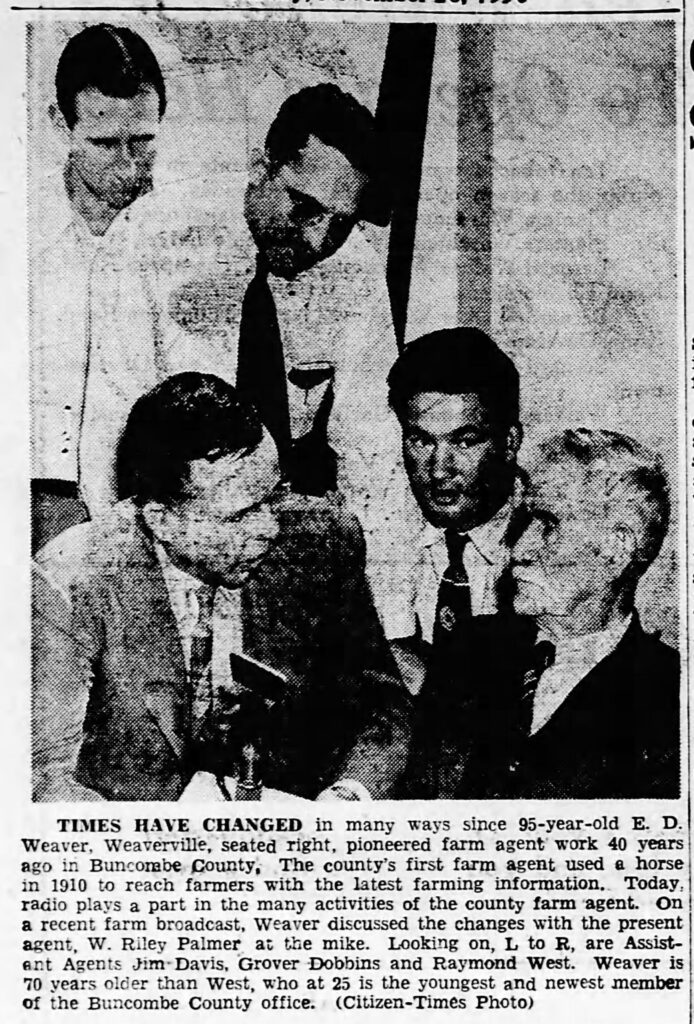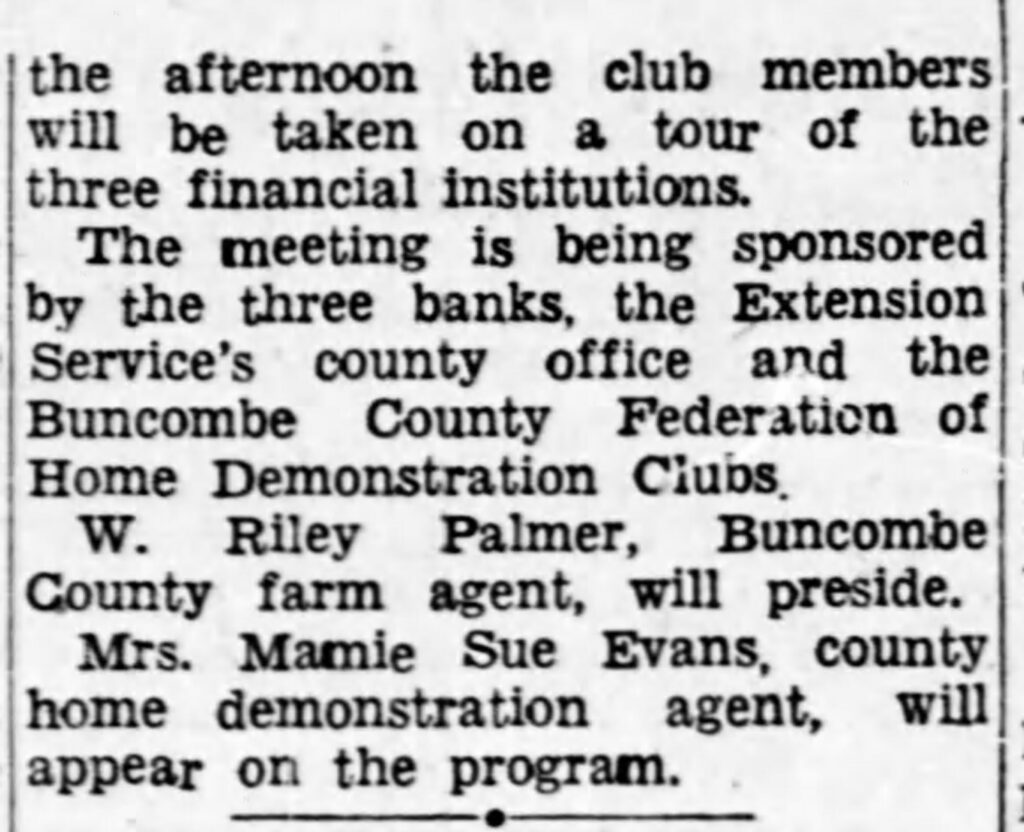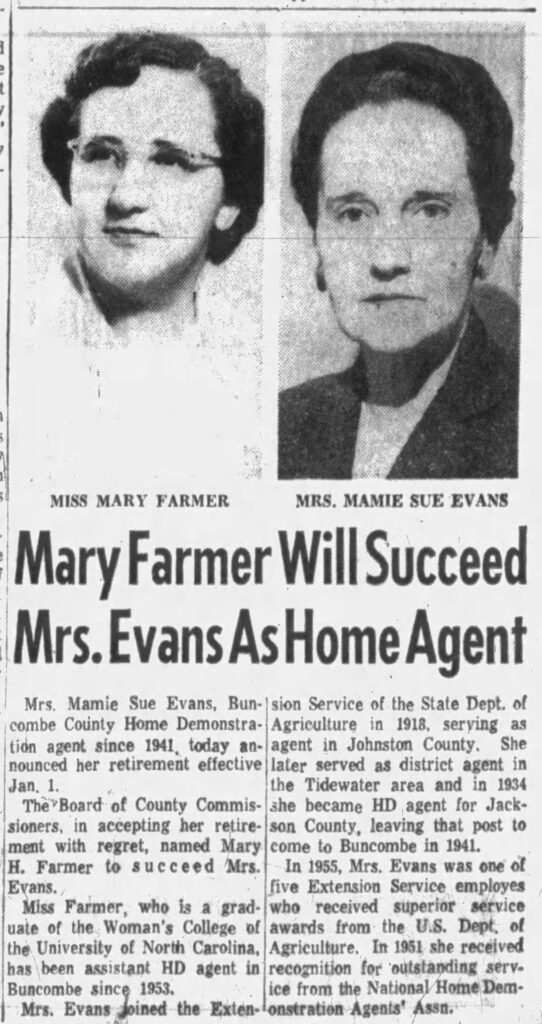Buncombe County Cooperative Extension : The 1950s
go.ncsu.edu/readext?1067204
en Español / em Português
El inglés es el idioma de control de esta página. En la medida en que haya algún conflicto entre la traducción al inglés y la traducción, el inglés prevalece.
Al hacer clic en el enlace de traducción se activa un servicio de traducción gratuito para convertir la página al español. Al igual que con cualquier traducción por Internet, la conversión no es sensible al contexto y puede que no traduzca el texto en su significado original. NC State Extension no garantiza la exactitud del texto traducido. Por favor, tenga en cuenta que algunas aplicaciones y/o servicios pueden no funcionar como se espera cuando se traducen.
Português
Inglês é o idioma de controle desta página. Na medida que haja algum conflito entre o texto original em Inglês e a tradução, o Inglês prevalece.
Ao clicar no link de tradução, um serviço gratuito de tradução será ativado para converter a página para o Português. Como em qualquer tradução pela internet, a conversão não é sensivel ao contexto e pode não ocorrer a tradução para o significado orginal. O serviço de Extensão da Carolina do Norte (NC State Extension) não garante a exatidão do texto traduzido. Por favor, observe que algumas funções ou serviços podem não funcionar como esperado após a tradução.
English
English is the controlling language of this page. To the extent there is any conflict between the English text and the translation, English controls.
Clicking on the translation link activates a free translation service to convert the page to Spanish. As with any Internet translation, the conversion is not context-sensitive and may not translate the text to its original meaning. NC State Extension does not guarantee the accuracy of the translated text. Please note that some applications and/or services may not function as expected when translated.
Collapse ▲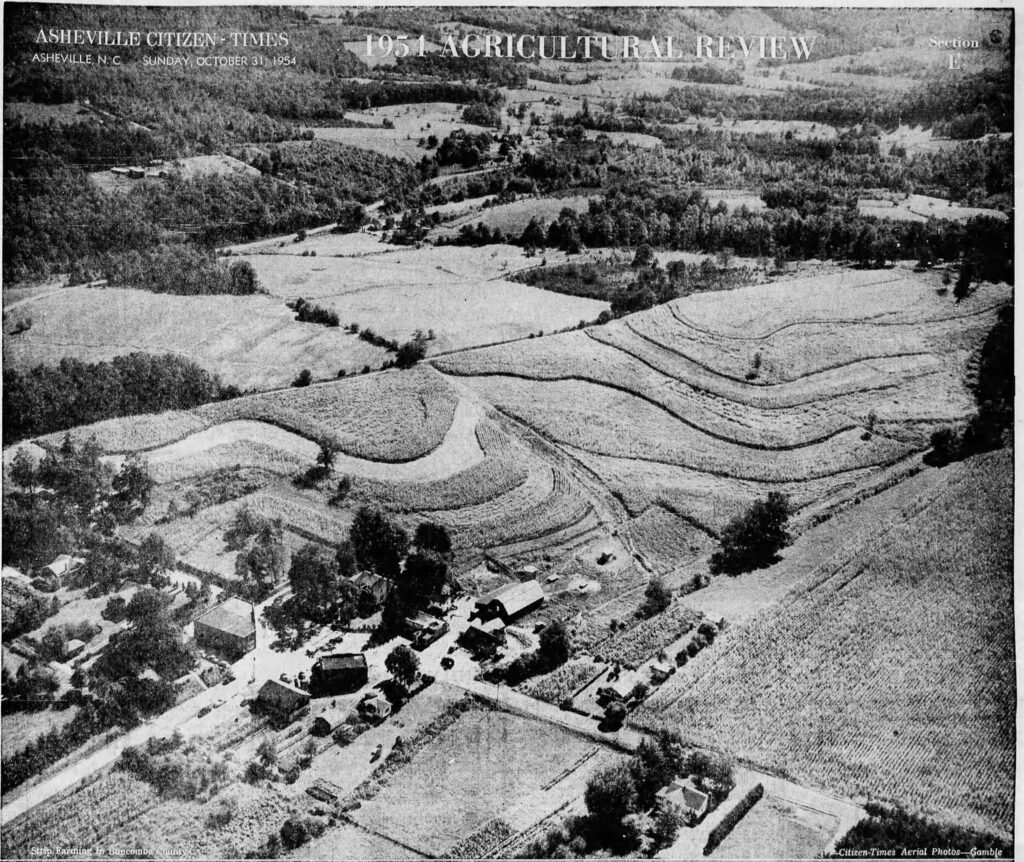
1954 Photo of the Arcadia Dairy Farm at the intersection of Brevard Road and Long Shoals Road, Avery’s Creek Community, South Buncombe County.
The Asheville Citizen Times newspaper.
Sunday, October 31, 1954.
Page 42.
The post-war decade of the 1950s marked a new beginning for our country. Having survived the Great Depression of the 1930s and the end of World War II, Americans now looked to the future with optimism. It was a time of strong economic growth and consumerism. New technology, such as television, made its way into American homes offering a new form of entertainment and a new way to get information. Two new states–Alaska and Hawaii–were admitted to the union and Elvis Presley, Lucille Ball, and Marilyn Monroe changed the entertainment world forever.
Tensions between North and South Korea, each supported by opposing countries, led to the Korean War. Fighting continued for three years, from 1950 to 1953, before a cease-fire was agreed upon.
Two notable events of the Civil Rights movement took place during the 1950s with the arrest of Rosa Parks for refusing to give her bus seat to a white man, and the Supreme Court case Brown vs. the Board of Education deeming racially segregated schools unconstitutional. Even with this victory, many schools were slow to follow suit and it was not until the late1960s that Buncombe County schools became fully desegregated.
In the early 1950s two superpowers, the United States and the Soviet Union, competed to be the first in space. Russia gained the upper hand with the launch of the Sputnik satellite, the first man-made object to orbit earth, on October 4, 1957.
Closer to home, burley tobacco proved to be a successful crop for many Buncombe County farmers, with Buncombe, Madison, and Yancey counties becoming top producers in the state. Dairying continued to be one of the major types of farming and vegetable production saw a boost as a major food manufacturing plant came to Asheville in the last years of the decade.
1950
The 1950 Agricultural Census lists:
4,266 – Farms in Buncombe County.
225,773 – Acres of land farmed. (53.7% of the county).
52 – Average farm size in acres.
34,118 – Acres dedicated to harvested crops.
September 23 – A group of Buncombe County farmers vote for the establishment of the Buncombe County Soil and Water Conservation District with 624 land owning voters in favor of and 85 voting against. The primary aim of the Conservation group was to provide technical advice on land terracing, reforestation, and erosion of overworked farm and pasture land.
The Buncombe County Soil and Water Conservation District continues to provide vital services and information to all citizens of Buncombe County concerned with land and water conservation, farmland preservation, wildlife education, and other land related topics including Hurricane Helene recovery. Their website can be found here: Buncombe County Soil and Water Conservation District.
November – Buncombe County Cooperative Extension celebrates its 40th year of service.
1951
September 3 – A group of eight farm and government agricultural leaders from France arrive in Asheville. Farm agent Riley Palmer serves as chaperone, escorting the group to various Buncombe County farms and dairies. Methods and techniques studied included pasture improvement, production, conservation, harvesting, and forage crops. Upon their return to France, their goal was to use the information to boost their county’s production of milk and meat by 25 percent above pre-World War II levels.
1952
April – A new type of barn, the first of its kind in Buncombe County, is built on Waitsell Plemmons’ Leicester farm. Designed by agricultural engineers at NC State University with hinged doors to provide better ventilation and to hold at least one acre of tobacco harvest, the 24′ x 48′ barn was built on high ground facing the prevailing winds. The total price for the new barn was $1,116.04. Mr. Plemmons saved money by using lumber from his own trees.
April 11 – At a time when women’s banking opportunities were restricted, personnel from Asheville’s three banks, Wachovia, Bank of Asheville, and First National Bank, in cooperation with Buncombe County Cooperative Extension, and NC State University Extension, hosted a workshop on farm credit and farm money management.
May – Eleven state agencies, including Buncombe County Cooperative Extension, take part in “The Challenge,” a new agricultural development program to inventory the stock and income of rural families of Buncombe County. Inventory included the farm family’s income, crops being raised and crops needed, idle lands and potential use of, livestock owned, family nutrition, modern plumbing and other items. The information was obtained to provide the help needed in those areas.
It is well known that agricultural workers have always and continue to face a unique set of challenges that can effect their mental health. Help and resources are available. More information from NC State University can be found here: Farmer and Rural Mental Health Resources.
1953
April 9 – The Western Carolina Livestock Market, Asheville’s newest livestock auction, opens directly across the French Broad River from the Asheville Livestock Yards on Riverside Drive. Annually, the Asheville Livestock Yards disbursed roughly $5,000,000 (approximately $60,000,000 in today’s dollars) to area farmers for their cattle, sheep, hogs and other livestock prior to the new auction’s opening. Now home to New Belgium Brewery in the River Arts District, this Craven Street facility served the Asheville and surrounding area until closing in December, 2004.
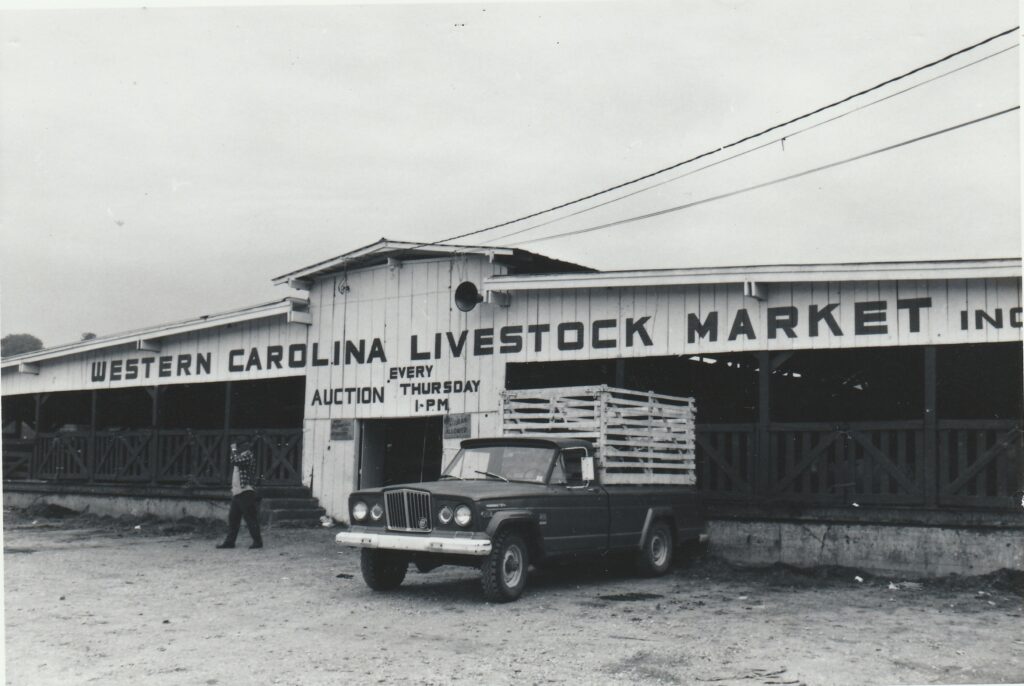
1960s Photo of the Western Carolina Livestock Market.
Present day location of New Belgium Brewery.
Craven Street, Asheville.
Photo courtesy of Buncombe County Cooperative Extension.
1954
November 30 – A record opening day sale is recorded for the Asheville burley tobacco market with producers being paid $58.89 per hundred pounds of tobacco. This equalled $427,740.98 ($5.1 million in today’s dollars) being paid to local tobacco growers.
Burley tobacco became a crucial and profitable cash crop for many in Western North Carolina during the early 1900s. With the advent of New Deal programs introduced by president Franklin D. Roosevelt in the 1930s aimed at helping farmers, the government established tobacco “quotas” or rights, given to farmers to produce a certain amount of tobacco. This enabled the government to control the market and keep prices high for farmers. Quotas were valuable commodities to the farmers and could be bought, sold, leased, and even inherited. For 66 years the quotas remained in effect, allowing the federal government to stabilize the tobacco market and ensure a continuous income for many families.
This way of life continued for tobacco farming families until the 1990s when a group of states, North Carolina included, filed a major lawsuit against four large tobacco companies, suing to recover financial costs associated with treating illnesses related to cigarette smoking.
In 1998, this lawsuit resulted in the Master Settlement Agreement and ordered the four tobacco companies to pay $206 billion to 46 states. North Carolina was one of these states, receiving $4.6 billion in funds over 25 years.
More changes came in 2004 when the federal government initiated a buyout of tobacco farmers’ quotas. All tobacco farmers who had participated in the quota system were compensated for releasing their quotas. This led many tobacco farmers in Western North Carolina to retire or transition to other agricultural crops, marking a significant shift in the region’s agricultural landscape and way of life.
1955
October 30 – The Asheville Agricultural Development Council’s 1955 Rural Community Development Contest is the largest in its five years. A total of 105 communities entered, highlighting their efforts to enhance their quality of life. These efforts included stream clearing for flood prevention, setting up community markets, soil and wildlife conservation projects, and acts of neighborly support during times of need.
1957
October 28 – Mamie Sue Evans, Buncombe County Home Demonstration Agent since 1941, announces her retirement.
1958
March 10 – Gerber Products Company announces plans to build a baby food manufacturing plant in Asheville. Located on Hendersonville Road at the present-day location of Gerber Village, adjacent to the Publix grocery store, this factory provided over 700 jobs and gave local farmers a new market for their fruit and vegetable crops.

Gerber Baby Food Factory.
Hendersonville Road, Asheville.
Present day location of Gerber Village, adjacent to Publix grocery store.
Photo courtesy of Buncombe County Special Collections.
Pack Memorial Library, Asheville, North Carolina.
As the 1950s came to a close, Buncombe County Cooperative Extension began planning for the next decade. Plans for 1960 and beyond included working with farmers to grow beans, carrots, beets, squash and apples for the new Gerber baby food factory. Special attention was also planned for farmers in the western section of Buncombe County in growing tomatoes after Haywood County’s new fruit and vegetable processing plant was opened in Waynesville. Efforts to help farmers maintain the county’s top farming enterprises—poultry, dairy, and tobacco— were on the forefront of farm leaders’ and businesspeople’s minds, and by the end of 1959, thirty-two 4-H clubs provided learning opportunities for over 2,000 Buncombe County school-aged children.
Stay with us through the month of June as we follow the changes and events of agriculture and Cooperative Extension work in Buncombe County from 1960 to 1969.
Follow our history all year long as we explore each decade of North Carolina Cooperative Extension work in Buncombe County:
Buncombe County Cooperative Extension: Beginnings to 1920
Buncombe County Cooperative Extension: The 1920s
Buncombe County Cooperative Extension: The 1930s
Buncombe County Cooperative Extension: The 1940s
Sources:
Boyle, John. “Tobacco at a Turning Point.” The Asheville Citizen Times, 15 June 2003, Accessed 2025. Newspapers.com.
“Buncombe Organizing for Program.” The Asheville Citizen, 5 May 1952, Accessed 17 Apr. 2025.
“Burley Brings $58.89 Average.” The Asheville Citizen, 1 Dec. 1954, p. 1, Accessed 17 Apr. 2025.
“Community Development Program Reaches New Peak.” The Asheville Citizen Times, 30 Oct. 1955, p. 6, Accessed 17 Apr. 2025.
Coulter, Adam. “Avery’s Creek United Methodist Church – Celebrating 150 Years.” Unpublished. 2019.
“County Soil Conservation Program Favored, 624 to 85.” The Asheville Citizen Times, 24 Sept. 1950, p. 12, Accessed 17 Apr. 2025.
“CPI Inflation Calculator.” U.S. Bureau of Labor Statistics, U.S. Bureau of Labor Statistics, www.bls.gov/data/inflation_calculator.htm. Accessed 17 Apr. 2025.
“Eleven Agencies Plan Inventory of Farms.” The Asheville Citizen, 30 Apr. 1952, p. 11, Accessed 17 Apr. 2025.
“Farmers of Buncombe To Vote on Soil Plan.” The Asheville Citizen Times, 3 Sept. 1950, p. 11, Accessed 17 Apr. 2025.
“First New Type Burley Barn Built in Leicester.” The Asheville Citizen, 14 Apr. 1952, p. 9, Accessed 17 Apr. 2025.
“Gerber Products Co. Buys Plant Site Near City.” The Asheville Times, 10 Mar. 1958, p. 1, Accessed 17 Apr. 2025.
Hunt, Max. “Smoke and Mirrors: The Death of Tobacco in WNC.” Mountain Xpress, Mountain Xpress, 22 Feb. 2016, http://mountainx.com/news/smoke-and-mirrors-the-death-of-tobacco-in-wnc/#:~:text=Few%20crops%20have%20been%20as,many%20Western%20North%20Carolina%20farmers.
“Leicester Farmer to Build New Type Leaf Curing Barn.” The Asheville Citizen, 9 Jan. 1952, p. 16, Accessed 17 Apr. 2025.
“Marketing Services for Livestock Farmers in WNC Area Are Expanded.” The Asheville Citizen Times, 25 Oct. 1953, p. 5.
“New Livestock Market to Be Built Here.” The Asheville Citizen, 6 Dec. 1952, p. 9, Accessed 17 Apr. 2025.
“Plans Made for French Leaders’ Tour.” The Asheville Citizen, 3 Sept. 1951, p. 9, Accessed 17 Apr. 2025.
Ramsey, Gertrude. “Buncombe County Agent’s Office Now In Its Fortieth Year.” The Asheville Citizen Times, 26 Nov. 1950, p. 6, Accessed 17 Apr. 2025.
“Rural Housewives to Learn About Banking and Credit.” The Asheville Citizen, 11 Apr. 1952, p. 17, Accessed 17 Apr. 2025.
Smith, Bernard. “Outlook for Farming In Buncombe Reported Good.” The Asheville Citizen Times, 11 Oct. 1959, p. 79, Accessed 17 Apr. 2025.
“Tobacco in North Carolina History, Part II – North Carolina History.” North Carolina History , John Locke Foundation, 21 Oct. 2024, http://northcarolinahistory.org/encyclopedia/tobacco-in-north-carolina-history-part-ii/.
“The Tobacco Industry in North Carolina, Part I – North Carolina History.” North Carolina History Project, John Locke Foundation, 13 Dec. 2024, http://northcarolinahistory.org/encyclopedia/the-tobacco-industry-in-north-carolina-part-i/.





